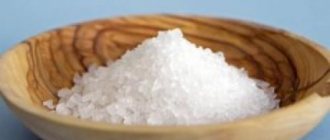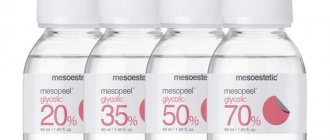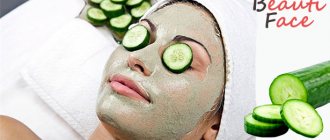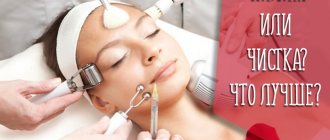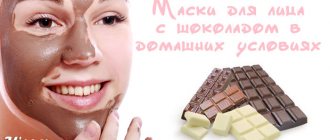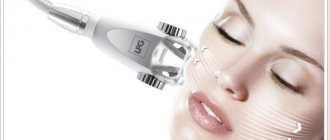Hello, dear readers. Today we’ll talk about ultrasonic facial cleansing at home. On the agenda:
- why is ultrasonic cleaning necessary;
- how to carry out ultrasonic cleaning;
- how to choose a device;
- indications and contraindications;
- how to do ultrasonic facial cleansing at home.
A woman's facial skin is delicate. If you take care of it incorrectly, by about 20-25 years the T-zone becomes covered with unattractive black dots.
At first they are small, barely noticeable, and gradually increase in size with age. Sometimes you can notice how a column of dense sebum with a dark cap rises from the pore.
Often the skin acquires a grayish-yellowish tint, peels off (at about 30+ years), and pigment spots are observed (age 45+).
Ultrasonic facial cleansing at home will help remove dead epidermal cells, even out complexion, and partially remove sebum from pores. Read about other types of facial cleansing in the article.
What is attractive about the procedure?
There are different ways to cleanse the skin: using lotions, gels, foams, scrubs, cleansing masks and other cosmetics that can be used at home, as well as procedures in beauty salons - peelings, mechanical, manual, hardware cleansing. Salon methods give a more noticeable effect, which lasts for a long time, but cause many side effects: trauma and microtrauma of the skin, its swelling, redness. Facial cleansing in a salon often requires a recovery period.
Why do many women prefer ultrasonic facial cleansing?
- The procedure is suitable for any skin type at any age.
- The skin is cleansed of comedones, gets rid of dead skin cells and oily sheen.
- Ultrasound affects blood vessels and connective tissue, increasing blood circulation and the production of collagen and elastane - the epidermis becomes more elastic, even, smooth, and its color improves.
- As a result of deep cleansing, the dermis absorbs cosmetics much more actively, and their effect is more pronounced.
- After the procedure, the epidermis does not redden, does not swell, and does not require a long rehabilitation period: cleansing is ideal for sensitive skin.
- The duration of the manipulation is only 30-40 minutes.
- Does not cause pain, only a slight vibration is felt.
Ultrasound cleansing can be alternated with other types of skin cleansing, replacing it with any peeling or mechanical cleansing.
Recommendations from cosmetologists
Cosmetologists advise women of all ages to carry out regular ultrasonic cleaning. Knowing how to properly do ultrasonic facial cleansing at home, you can prolong your youth. For girls, sessions help eliminate the problems of adolescence.
Interesting! The main working mechanism of the ultrasound apparatus is a plate or blade. If you sweep the tip over the surface of the skin, the effect will be cleansing. If you turn the scapula with its flat side, its effect becomes massaging. The applied cosmetics heat up and begin to be actively absorbed, forming micro-jets. Pores expand, dead skin particles easily flake off. Along with them, excess sebaceous and other contaminants are removed.
Cosmetologists highlight the following features of ultrasonic cleaning:
- harmlessness;
- a small number of contraindications;
- all-season – can be carried out at any time of the year;
- versatility - skin type does not matter;
- absence of allergic reactions;
- there is no need to prepare for sessions;
- no aftercare required;
- the integrity of the skin is not compromised, only its dead parts are removed;
- there is no need for stretching, pressing or steaming.
Ultrasonic cleansing of the skin can be repeated every 10 days. The sessions take place without any unpleasant sensations, leaving no redness, swelling or other abnormalities. It is best to do the procedure in the evening.
Cosmetologists recommend that before starting a session, make sure that it is not contraindicated. In rare cases, skin ultrasound can be harmful.
More details in the video from a cosmetologist:
How is ultrasonic cleaning performed?
The procedure consists of several stages:
- The cosmetologist prepares the face: removes makeup, cleanses, applies a special mask to open the pores.
- The skin is covered with a special gel, which allows the ultrasound waves to work in the epidermis (they simply die out on dry skin), and also saturates the dermis with useful substances.
- Cleaning is carried out directly: the device for ultrasonic facial cleansing is equipped with a spatula (scrubber), which the cosmetologist moves over the face. The scrubber emits ultrasound waves and removes loose dirt. The device literally pushes dirt, sebaceous plugs, and cosmetic residues out of the pores.
- At the end of the manipulation, a soothing facial massage is performed, a restorative mask and moisturizer are applied.
Ultrasound rays have several types of effects on the dermis:
- mechanical - sound waves create pressure on tissues, massage them, increasing the conductivity of cellular structures;
- thermal - the heat of sound vibrations warms up the skin, it becomes softer, more elastic, and pliable;
- physico-chemical - ultrasound accelerates molecules, as a result of which metabolic processes in the epidermis proceed faster.
Are there any contraindications?
Ultrasonic facial cleansing is not recommended if:
- rosacea, if the disease has progressed to stage 3-4;
- acute or chronic skin diseases;
- oncological diseases;
- neuralgia of nerve endings;
- if other cosmetic procedures were performed the day before: Botox or chemical peeling;
- pregnancy.
If there is one of the above reasons, you should consult your doctor. Depending on the state of health, the doctor may allow or prohibit ultrasound. For example, during pregnancy, ultrasonic cleaning is not so much a contraindication as an additional precaution.
Indications and contraindications
It makes sense to choose ultrasonic facial cleansing if you have the following problems:
- enlarged pores;
- comedones, acne;
- oily or combination skin with a greasy sheen;
- initial age-related changes;
- dull, unhealthy complexion;
- loss of elasticity and skin turgor.
Ultrasonic peeling also has contraindications:
- exacerbation of acne;
- damage to the skin on the face (burns, cuts, boils, etc.);
- noticeable capillary network;
- carrying out chemical peeling, rejuvenation procedures, surgical interventions on the face less than three months ago;
- the presence of metal crowns, brackets, braces, pins;
- gel contour plastic surgery, silicone implants;
- presence of a pacemaker;
- heart and vascular diseases;
- elevated temperature;
- respiratory tract diseases;
- neuralgic disorders;
- hypertension;
- oncology.
The period of pregnancy and breastfeeding, moles or other formations on the face require prior consultation with a doctor and obtaining his permission to perform the procedure.
Side effects of ultrasonic facial peeling
However, side effects after ultrasonic facial peeling are rare, but they do occur. Subject to the previously described rules, we are usually talking about the individual characteristics of the client. But don’t forget about the human factor, because it’s difficult to guarantee anything when a person is working. The most common side effects include swelling in the area affected by the device, redness, painful peeling of the epidermis (sometimes with the appearance of blood), increased dryness or oiliness of the skin, pain in the area of the procedure.
The described complications often scare clients away from this type of peeling, but here you should pay attention to the frequency of side effects. As a rule, these are isolated cases, and in order to protect yourself from possible risks, you just need to very carefully choose the location of the procedure and the specialist who will work with you.
It would be a pity, because of my prejudices, to refuse the most effective procedure to date for deep cleansing and restoring a healthy appearance to the skin. Who doesn't want to get a glowing face quickly, without pain or damage to the skin, while spending a reasonable amount of money. Therefore, carefully analyze all the information received and make the right choice.
Ultrasonic cleaning at home
Ultrasonic cleansing can be done at home yourself if you purchase a manipulation device, the appropriate gel, and learn how to use them. You can choose a gel and device by studying reviews and instructions for use, but only frequent practice will allow you to master all the intricacies of the procedure.
Experts warn that carrying out such experiments on yourself is fraught with side effects:
- swelling;
- skin redness;
- inflammation;
- discomfort or pain;
- local burns;
- tightness and flaking of the skin.
When carrying out home cleaning, you must avoid the neck area, otherwise you can seriously disrupt the functioning of the thyroid gland.
The result of home care is usually less pronounced than in a salon, including because salons use professional equipment and cosmetics. By trusting a specialist, you will get a stronger effect without injuries or other unpleasant consequences.
Facial care after cleansing if complications arise
The most common complication that appears due to the inexperience or negligence of a cosmetologist during cleaning is poorly healing wounds. However, the cause may also be careless skin care after it. In this case, it should be treated with chlorhexidine, alternating it with infusion of chamomile or calendula. Before undergoing the procedure, you should make sure that the skin is not affected by a viral or fungal disease - most often, prolonged regeneration is associated with this. If the disease was not detected, but was present, facial care after cleansing should include the use of antibiotics, for example, you can spot-smear the affected areas with a solution of chloramphenicol.
If the effect is short-term, it is better to visit a dermatologist. He will do certain tests and identify what is causing complications and loss of effectiveness, and, if necessary, prescribe treatment. If facial cleansing has been performed, post-procedure care should comply with the cosmetologist’s recommendations. It happens that the cleaning itself was done efficiently, but inept care reduced the entire effect to zero. Therefore, you should remember that the main thing for skin restoration during this period is hydration and nutrition. There should not be any aggressive lotions in your arsenal - gentle home care would be an ideal option. Contraindications also should not be an empty phrase - their presence will aggravate the situation and delay the regeneration process for a long time.
How to choose an ultrasonic cleaning device?
The choice of portable ultrasound devices is large. To choose the best one for yourself, you should consider the following parameters:
- vibration frequency of ultrasonic waves - the result of the procedure mainly depends on this characteristic; in professional devices it averages from 24 to 30 kHz; in a home model, the frequency should be close to these values;
- power - it gives the depth of penetration of waves into the skin; focus on 0.5-2 W;
- operating modes - the more there are, the more accurately you will find the one that suits your skin;
- additional functions – the more procedures you can perform using the device, the better; some models perform microcurrent rejuvenation, iontophoresis, galvanic lifting and other useful manipulations;
- battery, weight and size - these parameters make the device convenient to use;
- brand recognition - a reputable manufacturer guarantees the safety and uninterrupted operation of the product.
Indications for the procedure
Cosmetologists use ultrasonic exfoliation for the following conditions:
- comedones, acne;
- unhealthy, dull color;
- swelling, impaired lymphatic drainage functions;
- signs of aging, fading;
- networks of wrinkles;
- pigmentation;
- wide pores, lumpy structure;
- dehydrated, dry, irritated skin.
It is effective for general improvement, as part of a treatment or rejuvenation program. The condition of the skin is normalized, the functioning of the sebaceous glands and hydrobalance are restored. Unfortunately, the procedure will not help get rid of stretch marks, scars, acne scars. Sound waves act superficially and do not affect the dermal layers. For these purposes, deep peelings are prescribed, comparable to plastic surgery. Also not applicable to the eyelid and perioral areas.
How to care for your skin after cleansing?
After the skin has been exposed to an ultrasound cleaning device, it needs maintenance care. Ultrasonic peeling does not damage, but dries the skin, which is very good for the epidermis, which is prone to greasiness. However, after the manipulation, the skin should be pampered with moisturizing creams, serums, and regenerating masks. It is better to choose cosmetics from the “sensitive skin” segment.
To ensure that the effect of the procedure lasts as long as possible, treat your skin with care and attention:
- use sunscreen (SPF at least 20);
- within 24 hours after cleaning, do not visit the solarium, beach, sauna, or gym;
- Do not use decorative cosmetics for 24 hours;
- cleanse the skin using gentle products;
- replace cosmetics containing alcohol with alcohol-free analogues;
- drink more clean water.
Violation of the technique, time or intensity of the procedure may negatively affect the condition of your
Procedure execution algorithm
The algorithm for mechanical and ultrasonic cleaning has many similarities and differences. Both procedures begin with preliminary cleansing of the skin from decorative cosmetics, creams, as well as any surface contaminants. Then, according to indications, light peeling , eliminating dead cells from the surface of the skin; it is carried out to facilitate access to impurities.
The next step is steaming the skin . The purpose of the treatment is to maximize the opening of pores for the subsequent accelerated removal of blackheads and sebaceous plugs. It can be carried out using masks, steam baths, and special devices.
The main stage is processing. During mechanical cleaning, it is carried out by hand, as well as using special products made of medical steel (needles, spoons). The principle of action is extremely simple and consists of mechanical pressure on problem areas in order to push impurities to the surface of the skin. Such manipulations can be quite painful, but no anesthesia is provided during the procedure.
The effect during ultrasonic cleaning is more pleasant and is not associated with any discomfort for the patient. The principle of operation is to knock out contaminants from the pores using acoustic vibrations.
At the end of the procedure, it is necessary to carry out antiseptic treatment of the skin in order to reduce the secretion of sebum and eliminate possible microorganisms. Many cosmetologists prefer to complete the procedures with therapeutic masks that soothe the treated areas of the face.
In some cases, mechanical and ultrasonic cleaning can be combined and carried out together in one session; this procedure is called combined and allows for maximum removal of contaminants.
Mechanical facial cleansing
Functions and characteristics of the cosmetic device
Cleaning the pores of the facial skin from comedones and preventing skin problems, as well as the appearance of acne, is not difficult, thanks to beauty treatments that can be obtained most often in every beauty salon or beauty salon. There are also ways to cleanse your face in the field. It is not surprising that, according to the Society of Cosmetologists, one of the most popular procedures is facial cleansing using ultrasound (UCL), manipulation using short electric waves that penetrate deeply into tissues and improve blood circulation and the outflow of excess water stagnant in skin cells.
Ultrasonic cleansing is a professional skin care treatment that uses an ultrasonic device or ultrasound machine to cleanse delicate skin.
An ultrasonic device (not just a cosmetic device) uses a special cleaning solution and high-frequency sound waves. Ultrasonic frequencies range from 20 to 400 kHz, but most industrial cleaners operate in the 40 to 80 kHz range. The technique is used in many industries and can be used on many materials and objects of various sizes and shapes, going far beyond the scope of cosmetology.
An ultrasonic facial cleanser is called a scrubber. As a rule, this is an electronic unit with a special ultrasonic transducer that transmits impulses directly deep into the skin. A wire runs from this unit, and there are also models with batteries. The device works alternately, alternating impulses and a state of rest. The device itself includes a timer to control the duration of the procedure, as well as to select modes or intensity of power supplied.
In equipment stores you can find both professional equipment intended for salon or medical use, and devices for independent “home” use.
The main functions are the following:
- Skin cleansing;
- Massage of the upper layers of the skin;
- Acceleration of metabolic processes and collagen production;
- Improving the water balance of cells.
Ultrasonic waves range from 1 MHz to 3 MHz. Their effect on skin tissue is similar to a massage. Typically, this effect is called micromassage. It's like a million vibrations penetrating the skin cells at the same time. When using an ultrasonic massager, you may only feel a slight sensation of warmth or tingling. This is better for our delicate skin. Appropriate micromassage plays an important role in the physiological processes occurring in the skin. The speed of vibration and the impact of ultrasound can easily remove waste from the influence of the surrounding world, and this is, as a rule, dust, dirt, and also excess subcutaneous fat. Do not use directly on the inflamed part of the skin, especially if its condition worsens.
Under the influence of ultrasonic massage, the epidermis is saturated with oxygen.
The faster the vibration speed, the greater the effect the procedure gives, but you should not exceed the permissible standards in order to avoid traumatic moments.
Why use water-soluble gel
Ultrasonic waves require the use of gel for better conductivity and safe use. Research shows that the transmittance of ultrasonic waves in air is 0%, about 50% in ordinary water, 60% in distilled water, about 70% in an adhesive substance and more than 70% in a special conductive gel.
If we talk about water, then you should understand that it evaporates very quickly, especially considering that the procedure takes 15-20 minutes. The gel will remain on your skin even after you finish the procedure and will provide additional moisture.
Indications for use
Until recently, pores were cleaned using deep peeling procedures. Now ultrasonic facial cleansing is more effective, which can be performed in almost any beauty salon or clinic. The effect is based on improving local blood circulation and accelerating metabolic processes, which leads to increased collagen production, softening and rejuvenation of the skin. Recommended for use when:
- clogging and enlargement of pores;
- unhealthy appearance of the skin, dullness and sagging, decreased natural elasticity of the skin;
- the appearance of blackheads and pimples on the surface.
Facial cleansing technique
To get the effect, and in the future to maintain it, it is recommended to conduct a course of ultrasound procedures. The duration may vary depending on the time of year and skin condition and consist of 2-5 sessions. The ultrasonic facial cleansing protocol includes the following steps:
- The epidermis is pre-prepared for cleansing using suitable toners, moisturizing milk, lotion, etc.
- In some cases, additional hydration is necessary (especially with dull skin with visible age-related changes).
- The surface of the face is heated with steam using a special device. This is necessary for maximum pore opening.
- The face is treated with a gel that conducts ultrasound and also protects and nourishes the skin.
- After setting up the device, the procedure is started using the connected scrubber. All parts of the face are treated - the scrubber movements are performed in a circle.
- The ultrasonic cleaning procedure takes about 15-25 minutes, during which the pores are freed from impurities, which are then removed with a special bactericidal wipe.
- Sometimes after ultrasonic cleaning, phonophoresis is carried out with nutrients.
- At the end of the cleansing, the face is treated with a soothing cream, which will help eliminate possible irritation of the facial skin after the procedure.
Pros and cons of using an ultrasonic device
Like any cosmetic procedure, this manipulation has a number of features, as well as positive and negative features.
Advantages:
- during cleaning, the epidermis is not subjected to aggressive influence and is not injured;
- cleaning takes less time, unlike other similar procedures;
- In addition to facial cleansing, the device performs a delicate tissue massage;
- ultrasound has a positive effect on local blood circulation and immune processes;
- Skin elasticity increases.
Flaws:
- The harm of ultrasonic facial cleansing can only occur in cases where the procedure was carried out unprofessionally or without taking into account contraindications;
- The high price of both the procedure and the device itself.
To avoid possible negative consequences, it is recommended:
- contact an experienced specialist with good recommendations;
- choose a period for the procedure when there is no scorching sun and frosty wind, or protect the skin from the possible negative effects of external factors;
- do not clean your face during menstruation;
- Do not perform the procedure too often (optimally - once every 2-3 months).

